Below is an archival copy of an interview originally posted at First Comics News on June 13, 2024.
--------
30 Questions for the 30th Anniversary of Rob Hanes Adventures with series creator/writer-artist Randy Reynaldo
 Randy Reynaldo is best known for his work on Rob Hanes Adventures. This is the 30th Anniversary of Rob Hanes and Randy was nice enough to stop by First Comics News for 30 questions over his 30 years with Rob Hanes.
Randy Reynaldo is best known for his work on Rob Hanes Adventures. This is the 30th Anniversary of Rob Hanes and Randy was nice enough to stop by First Comics News for 30 questions over his 30 years with Rob Hanes.
1 How did you first become interested in comics?
I was fascinated with both reading and drawing comics from a young age–one of my earliest memories was drawing my own Peanuts strip before I even started kindergarten. Of course, it was very crude and probably totally incomprehensible. In addition, inspired by the Adam West Batman TV show (which I saw on re-runs), I recall drawing Batman and Robin in various death traps they had to escape from as their arch villains looked on.
But it was the twin discovery of Sgt. Rock and Batman comics and, soon after, classic adventure comic strips in books about the history of comics that I borrowed from my local library and received as birthday and Christmas gifts, which really led to what I do today.
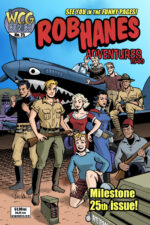
2 What comics did you read as a kid?
Although I remember reading a broad range of random comics early in life, ranging from a Tarzan comic to Dennis the Menace, Our Army at War featuring Sgt. Rock, purchased off a spinner rack at a local pharmacy store, was the first comic book I read regularly and collected. Keep in mind, this was before comic book stores existed, so this store and newsstands were my primary source of comics. I didn’t discover my first comic book store until around 1978 when my family moved from New York City to Northern California.
When I was a kid, I also had a fascination for World War II and war films, so latching on to Sgt. Rock was a natural. Friends also shared that Sgt. Fury and the Howling Commandos with me, so I was aware of that series too, but when I look back on those days, I realize now that the place I bought my comics didn’t carry many Marvel Comics, so those characters were never on my radar or part of my early comics reading. But I still liked the grounded “realism” of Sgt. Rock better. Aside from Sgt. Rock, I also enjoyed the Batman/Detective Comics titles.
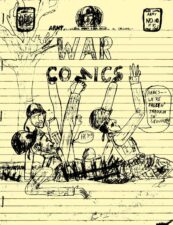
4 Can you tell us about your journey from Sgt. Hanes and Hell Platoon to focusing on his nephew in Rob Hanes Adventures?
It’s actually a pretty winding story, there were a lot of elements at play during this time of my life.
Because of my love for Sgt. Rock, I created Sgt. Hanes and Hell Platoon, which I drew on lined yellow steno pads, colored with colored pencils, stapled, and passed around to my classmates and around the school. Even then, the idea of being a comics publisher had an appeal to me, so naturally I called my imprint the “War Comics Group” (or WCG!). I actually produced around 24 issues of this title, so with Rob Hanes Adventures #25, I have finally now broken this personal record lol! These issues appeared from 1973-76 when I was in junior high school.

Around this same time, as I mentioned above, I also became interested more broadly in the history of comics. I borrowed from the library and asked as gifts many books on the subject–like Comic Art in America by Stephen Becker, Comics and Their Creators by Martin Sheridan, and The Great Comic Book Heroes by Jules Feiffer. These books introduced me to great adventure strips, like Terry and the Pirates, Scorchy Smith, Johnny Hazard, and Buz Sawyer. Although these books only provided small samples of these strips, the black-and-white art, and grown-up storylines and adventures that were set in the real world against real-life backdrops like World War II and the Cold War, really enthralled me. (I’ve always been a fan of spy stories and political thrillers too from a young age, like the Bond and Matt Helms films, as well as movies like All the President Men and Three Days of the Condor.) Around this time, the first reprints of strips like Terry (from Nostalgia Press) and Will Eisner’s Spirit (Warren Publishing) began appearing—this was the start of the comics reprint boom.
All these factors inspired me to redirect my focus to a spy/private investigator character, which I initially imagined as a syndicated adventure strip. Since I already had my Sgt. Hanes character, I simply used the same last name–though I’m sure I intended the characters to be related, it wasn’t part of any plan to build an extended “universe” per se. In my mind, they were two completely different characters and series.
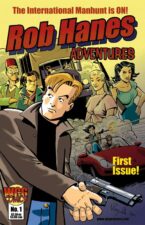
At this point, I was about 14 years old and working in a silo, in that I hadn’t really discovered comics fandom at this point yet, so this was all me just a youthful fantasy (or delusion). The adventure strip by then was already in decline and my work was incredibly raw and crude. But I did begin trying to make my work look more “professional” by drawing a proposed comic strip with India ink and brush for the first time. I even sent them to a few syndicates–I remember being a bit worried about what I would do if they actually bought this strip and I had to start meeting a daily deadline! I received at least one rote rejection letter. Given how crude and professional my work was, I’m sure they were just being accommodating and nice responding to what I’m sure they saw was the work of a kid. (Yes, I still have these sample strips and, no, I won’t ever show them.)
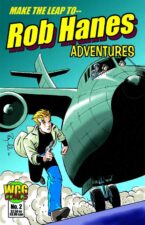
Throughout college, I kept a sketchbook, but It wasn’t until after college in the mid-1980s that I truly got serious about drawing the series as a comic book and producing comics at a professional level, meaning with brush, pen, and ink on bristol board paper. Alternative indie comics and publishers were starting to emerge, along with the first comic book stores, so I thought that might be an option. I began sending my work around—some publishers even expressed interest in the series, partly because at the time no one seemed to be doing such work. But I was still pretty raw and undeveloped.
Around this time, I also discovered the small press/fanzine community, which at the time was kind of its own ecosystem within comics fandom. So I began publishing my work as a zine, printing copies at local photocopy places, selling them by mail order through other zines, and comp copies to industry pros and publishers. This led to the series getting some attention and to my self-publishing it as a full-sized comic book, debuting as Adventure Strip Digest starring Rob Hanes, under my WCG Comics imprint. The first full-sized comic book issue came out in 1994, which is the year I formally mark as the start of WCG in the comics marketplace.
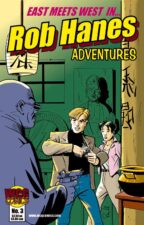
5 What tools and techniques do you use for creating artwork and writing scripts?
My scripts are formatted like a screenplay–it’s just for myself, so it’s just dialogue, narration, and some descriptions. Though I include where the page breaks happen, I actually don’t even break it down into panels–I sort that out when I break down and thumbnail the pages.
I began drawing comics years before personal computers were around, so I started out pretty traditionally with pen, brush, and India ink on bristol paper. But today, my pages are about 70 percent traditional and the rest is digital, done on a computer.
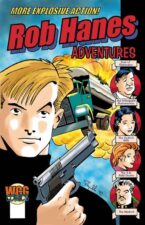
6 How did you learn to format a comic script or layout a comic page?
I’m completely self-taught, so a lot of it is instinctual and through study. Learning how to lay out a page was all from just doing it and practicing, based on learning the language of comics and how to tell a story by studying and internalizing the comics I was reading. Although there weren’t as many resources as there are today, I also collected books on doing comics, like How to Draw Comics the Marvel Way by John Buscema and Stan Lee and the Complete Book of Cartooning by John Adkins Richardson. But I don’t feel these books were particularly illuminating to me—I enjoyed them more for the glimpse they gave me behind the scenes of what pencils looked like and the nuts and bolts of life as a working cartoonist and comics professional.
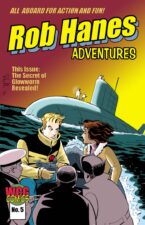
7 Who mentored you early on in your comic career?
As I mentioned earlier, I grew up and got into comics pretty much in a silo, unaware of comics fandom and no real connection to the comics industry until I was much older. It never occurred to me to go down that path, I just worked on my comics on my own. But industry people who were encouraging to me in those early days included Batton Lash (Wolff & Byrd) Scott McCloud (Understanding Comics), and inker Karl Kesel.
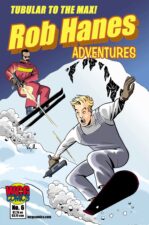
8 Which publishers did you approach to Publish Rob Hanes?
One of the first publishers to express interest in the series was Deni Loubert through her Renegade Press imprint, in the late 1980s. Deni was very enthusiastic about it and it was a great boost to my ego and that I was on the right track, but when I look back at my work at that time, I really wasn’t ready for prime time. But she explicitly said she loved the fact that nobody was doing work like that at the time, which was nice to hear. In fact, the first issue was solicited but then the company closed down. I also had some interest from Caliber Press and even Image at various points. But the timing was always bad and ended up as false starts and not happening. That’s when I decided to self-publish the zine, which later led to the comics.
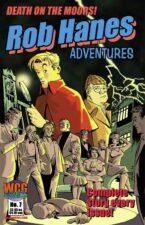
9 What challenges did you face when starting self-publishing?
Aside from start-up costs, it’s simply the challenge of getting noticed and standing apart from so many comic titles. I’m sure not publishing on a regular monthly or bi-monthly basis has also been a factor—without a constant, persistent presence in the market, building recognizability, momentum, and sales is a challenge. People at Diamond Comics Distribution, the main distributor at the time, and other small distributors all liked my work and were always supportive, and willing to carry and distribute my work. However, having an infrequent publishing schedule was a drawback.
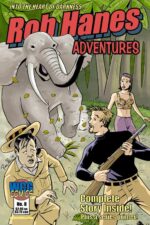
I started right when self-publishing began getting some attention in the early ‘90s. Dave Sim’s Cerebus had been around a few years and work like Jeff Smith’s Bone and Batton Lash’s Wolff & Byrd was starting to emerge. But it was also the end of the black-and-white comics boom. So my timing, as usual, was off. This was also the days when offset printing was the standard, which was relatively much more cost-prohibitive to small publishers than it is today now that we have print-on-demand printing.
10 As a small self-publisher, how did you attract readers for that first issue?
Through press releases and sending samples out—those were the days before social media or even the Internet!
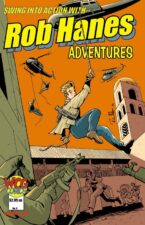
11 At the 30-year mark is it still difficult to find and attract new readers?
Only inasmuch as breaking through and being noticed with all the competing content out there is always a challenge. Fortunately, new readers are always coming aboard every year—all my stories are stand-alone and I have enough variety in stories that there’s an issue or more that news readers will find appealing to try out. It’s great when people discover the series and then come back to get more issues. I also often meet readers who say they’ve heard of the book or even picked up issues years ago and liked it, but didn’t know it was still going! I met two such people just at Comic Con Revolution last May. It’s always great when they’re happy to see it and pick up new issues.
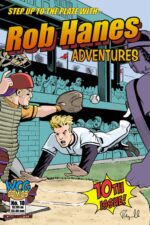
12 How has the comic book industry changed since the first issue of Rob Hanes?
As we’re seeing today, the distribution model, especially for self-publishers, has changed immensely. When I started, there were multiple distributors—including a few that specialized in small press distributors. Then Diamond Comics Distribution became the last man standing…but now, everything has been upended again Diamond has lost its exclusivity agreements with DC and Marvel.
Fortunately, today there are new distribution channels outside the direct sales market model, such as digital comics (Kindle and GlobalComix) and crowdfunding through platforms like Kickstarter. I often tell people that if I were starting out, crowdfunding is the way to go. But I’m too much of a dinosaur to change at this point!
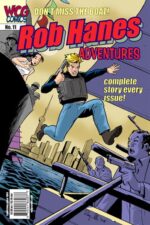
Let’s focus a little more on the characters, including the supporting cast and recurring villains.
13 How did you develop Rob Hanes as a character?
Rob is a classic protagonist in many ways, in that he’s a bit of an all-American everyman and intended as an avatar or stand-in for the audience. I have to admit because my stories are so tight, I still feel as though I haven’t yet fully fleshed out his back story or personal life enough for readers. One of his main flaws that I think makes him human and relatable is his somewhat misplaced self-confidence, which often is a source of humor in the series.
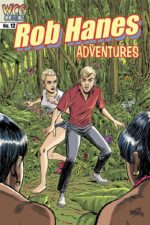
14 Who is Sydney Harwood and what is her relationship with Rob? Who is Abner McKenna?
Abner is Rob’s sidekick and mother hen. He’s an older detective who is more interested in avoiding trouble and keeping Rob out of danger. But he’s loyal and always comes through in the end.
Fun fact: Abner’s look and personality is closely modeled on the Uncle Billy character from the film, It’s a Wonderful Life, played by Thomas Mitchell.
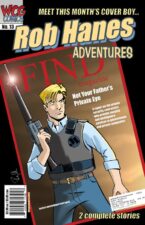
15 Who is Liz Tufts and how does she assist Rob in his missions? Who is Gabriel Evans Girard?
Girard is Rob’s boss and champion at Justice International. Justice International is a worldwide private agency with branches all over the world and Girard is the director of the New York City office. Other branch offices and their detectives have made appearances in the series, such as the Moscow, Tokyo, and Paris offices. As you can imagine, these offices sometimes work at cross purposes with each other.
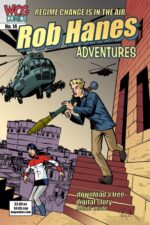
Girard can be grumpy, but he’s the one who hired Rob, and as a friend of his father, Patrick Hanes, in their early days at U.S. intelligence, is a bit of a father figure to him. He actually was envisioned as kind of an African American version of Police Commissioner Dolan from Will Eisner’s Spirit.
16 Who is Colonel Alcibiades Quill and why does he help Rob? Who is Tiffany Lance?
Tiffany is a reporter from Find magazine. As a reporter, she and Rob sometimes work at cross purposes, but they have a past history with each other and have had a long-lasting friendship, which you can find in the early stories of the series. Actually, I always see Tiffany as one of Rob’s main “friends with benefits” acquaintances!
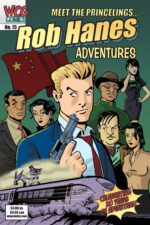
17 Who is Anton Goode and what is his relationship with Rob? What are some of your favorite recurring villains in the series?
There are so many I’ve introduced over the years! My favorite is probably Nikolai Korda, a sort of stateless crimelord with often shifting alliances. Rob has always been a constant thorn in his side, but though Korda’s activities are generally well known in the underworld and international police and intelligence agencies, he’s never been directly implicated in anything that’s led to arrest or trial.
Another favorite is Anthony Cromwell, a very corrupt, self-involved individual who’s always ready to sell anyone out for a quick buck. He is married to another favorite recurring character, Caroline Wilde, a spoiled rich girl who turned into a “good” character who remains committed to the marriage. She also has been a long-running love interest for Rob that remains unrequited. I should add that Cromwell is intended to be my one overt connection to the Terry and the Pirates universe—he is closely modeled on a character from that strip, Anthony Sandhurst—and is intended to be his grandson or somesuch.
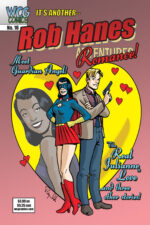
There are so many—Vasily Kerchenko, a disgraced Russian army officer who has found new life in the new Russian order; General Amra, a former Middle East dictator, and strongman that Rob helped bring down after several run-ins with him over the years; Vojislav Bolkan, a former Eastern European warlord; Napoleon Pope, a more low-level bandit, and warlord. There are so many to keep track of now, I had to start a list because sometimes I forget what their last disposition is so that if I bring them back, I can explain how they came back for any readers who follow continuity.
18 Who is Inspector Orsini and is he a friend or an adversary? And among the recurring characters?
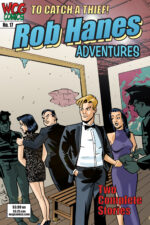
Many here as well. Julianne Love is a secretary at Justice International with a crush on Rob. Dennis Winger and Jarrett Cox are Rob’s primary CIA handlers and contacts, who always play good cop/bad cop to him. Irina Taushinova is a former Russian spy turned Justice International Moscow operative. There is Lorelei Thornfield and her two aunts, the two Lady Agathas, two English matrons who love danger and mystery, and often bring Rob in to work for them; Princess Chulaborn, an exiled Middle East princess who had a secret romance with the head of a rebel faction in her country, Sayed Farzi.
19 Who was Glowworm?
Glowworm was one of the earliest and first major story arcs in the Rob Hanes Adventures series. It was the codename for a U.S. intelligence agent who was a double agent for the Soviet Union during the Cold War, and who may or may not have been Rob’s father, Patrick Hanes—his father was a CIA operative who disappeared when Rob was a child, presumably because he was about to be exposed. Without giving away the ending, I did resolve the mystery when Patrick resurfaces in Rob Hanes Adventures #6.
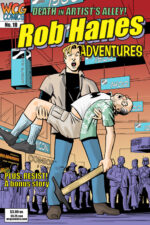
20 Why did they think Patrick Hanes, Rob’s Father, was a Soviet Spy?
Again, I don’t want to give away any spoilers, but all evidence seemed to suggest he was a Soviet mole, and his disappearance right before his arrest didn’t help his case!
I’ve actually always wanted to do an adventure featuring Patrick Hanes. To show how long I’ve worked on this series when I first thought about it, I planned to include a scene near the end where Patrick would be thanked by the President for his work—President Nixon! Rob would have been with him as a young boy and afterward, Rob would ask his father if Nixon was a good President, and Patrick would say, “The best!” But obviously, that joke wouldn’t work now with the change of time…who knows, maybe I can update it with another president!
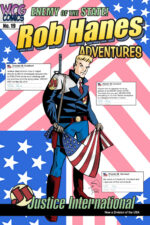
21 Who is Rob’s Mother?
His mother was Sharon McCay, a member of the prominent McCay family political dynasty—her father, Rob’s grandfather, is a former prominent U.S. senator, Thurmond McCay. I always intended the McCays to be Kennedy-esque, something I haven’t gotten around to exploring more fully yet though I’ve always wanted to.
22 What is Rob’s relationship with Thurmond McCay like?
Strained—Senator McCay wanted Rob to enter the family business, either in politics or finance or business. But Rob has too much of his father in him, preferring a more active and thrilling lifestyle with a sense of justice, rather than being stuck behind a desk pursuing money or power—in fact, Rob sees that as a path to corruption and the dark side!
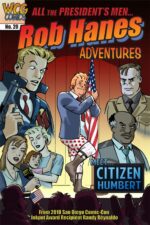
Let’s focus on the storytelling
23 How do you balance the action and humor elements in your stories?
Frankly, it’s mostly instinctual and comes pretty naturally to me—I tend to skew more light and humorous, than dark and gritty. And, of course, it depends on the story. Some stories are intended to be comedies from the outset, other times it’s just a small entertaining part of the story. I often try to get across the fact to new readers that my book isn’t dark or gritty, and that’s partly a reflection of my personality. At the same time, I try to keep the stories and characters grounded, so hopefully both the action and humor emerge naturally.
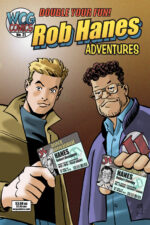
24 Can you walk us through your creative process from concept to finished product?
I often say my stories are ripped from the headlines—I’m a bit of a news junkie and many articles, incidents, and current events both big and small are filed away in my mind or in a file for possible future reference. Films, books, and TV can also be sources of inspiration. Usually, these stories are just something that drives an adventure or adds a little texture to a story, other times it may be something I’m actually commenting on. A good example is “Rob Hanes and the Pirates” in issue 11, where Rob is captured and held prisoner in North Korea. I had read a story about a few U.S. soldiers who, during the Korean War, had deserted and defected to North Korea, then resurfaced decades later, having made a life there and had a family. That story fascinated me and it became an important plot point in the issue. A sequence in issue 9 was inspired by the film Black Hawk Down and in issue 2 by a story about Cold War era nuclear “suitcase” bombs being out in the wild. I have tons of examples.
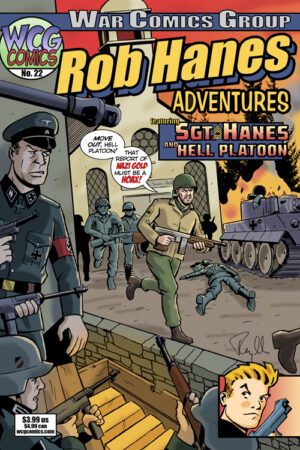
Once I come up with a basic story outline, I script, do thumbnails and layouts, and then do the finished art, working one page at a time in order. The original art is then scanned, where I add the lettering, graytones, and some other tones and elements digitally, primarily using Clip Studio Paint (CSP).
When I started out, desktop computers were not part of the comics production process, so everything I drew—including the lettering and even the zipatone graytones—were all on the final finished art. And those pages of original art look beautiful and have a nice tactile quality to them.
Today, about 70 percent of the art is drawn traditionally with pen, brush, and ink over pencils, the rest is digital, such as the lettering and graytones. So these days my original art now looks incomplete and unfinished. In fact, I’m often unhappy with the finished original art and only feel like it’s been “saved” after I finish it digitally—as I’ve realized, that that’s because the page isn’t really finished yet until I’ve added the digital elements.
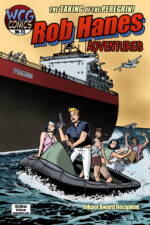
And more digital is always creeping in. For example, issue 25 is the first issue where all the panel borders were drawn with Clip Studio Paint. And sometimes when I can’t decide whether to lay in black in a panel, I just leave it open and drop it in digitally since it’s so easy to remove it if it doesn’t work. I occasionally use 3D modeling for elements that are easier to do that way, usually something mechanical or inorganic with a lot of repeating elements, like windows on a building.
25 Are all the Rob Hanes Adventures single-issue stories?
All stories are stand-alone, though if you are a regular reader, you’ll have the advantage of seeing overarching story arcs playing out in the background, along with recurring characters and villains.
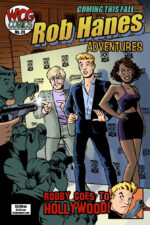
26 Can readers pick up any single issue of Rob Hanes Adventures and not need to know any backstory?
Definitely. As long as the reader understands the basic premise—a globetrotting private eye series—they’ll have no trouble following and understanding the story. If any context or backstory is needed, I provide it naturally within the story or via an editor’s note on the page. I also provide a primer on the inside front cover of every issue to introduce them to any recurring characters or situations that appear in the issue.
27 How do you handle the business side of being a comic creator, such as marketing and distribution?
 I actually enjoy that part quite a bit! Even when I was drawing my own comics as a kid, I liked the idea of being a “publisher,” which included creating and laying out the editorial and letter pages, designing the comic book and trade paperback package, etc. I actually had a sort of Stan Lee persona in those comics—something I gave up as an adult lol. That said, I’m also an introvert and not always completely comfortable promoting myself or putting myself out there. Today, the artist often has to be part of the brand, and I’m definitely from the school of thought that the work should speak for itself. But for better or worse, that’s not how comics or the entertainment and media environment work today. And believe it or not, I do enjoy the other nuts and bolts of business aspects of maintaining a business, such as bookkeeping and keeping track of sales and inventory.
I actually enjoy that part quite a bit! Even when I was drawing my own comics as a kid, I liked the idea of being a “publisher,” which included creating and laying out the editorial and letter pages, designing the comic book and trade paperback package, etc. I actually had a sort of Stan Lee persona in those comics—something I gave up as an adult lol. That said, I’m also an introvert and not always completely comfortable promoting myself or putting myself out there. Today, the artist often has to be part of the brand, and I’m definitely from the school of thought that the work should speak for itself. But for better or worse, that’s not how comics or the entertainment and media environment work today. And believe it or not, I do enjoy the other nuts and bolts of business aspects of maintaining a business, such as bookkeeping and keeping track of sales and inventory.
The downside, of course, is that this takes time away from being able to simply work on my comics. But I’m a one-person operation, so it’s all on me. I sometimes joke that if I wanted to spend all my time promoting my work on social media, I easily could—but then would have no time to produce my comics. So it’s definitely a balance and a challenge.
 28 How do you stay motivated and inspired to continue creating comics, especially during challenging times?
28 How do you stay motivated and inspired to continue creating comics, especially during challenging times?
If I didn’t have the passion and motivation to continue working on the series, I wouldn’t do it. It’s all on me. But having new stories I’m excited to tell and story ideas that still come to me keep me enthusiastic about working on the series. I like to believe that keeping stories self-contained and telling stories with different tones and in different genres also helps keep the series fresh and surprising, with a little bit of reinvention of every issue.
 29 How has offering digital editions impacted Rob Hanes, is this a significant portion of the readership?
29 How has offering digital editions impacted Rob Hanes, is this a significant portion of the readership?
At this point, not much. The print edition is still my focus and the primary vehicle for the series. The digital editions—on Amazon Kindle/Comixology, GlobalComix, and Hoopla—are just additional channels for exposure.
30 Finally, where can readers find your 30th Anniversary issue of Rob Hanes Adventure?
They can order the issue and all my other back issues–including trade paperbacks–directly at my website at wcgcomics.com and wherever I exhibit. My main show has always been the San Diego Comic-Con, where I always debut my newest issue. This issue will be available with a specially reduced fee for shipping.

No comments:
Post a Comment